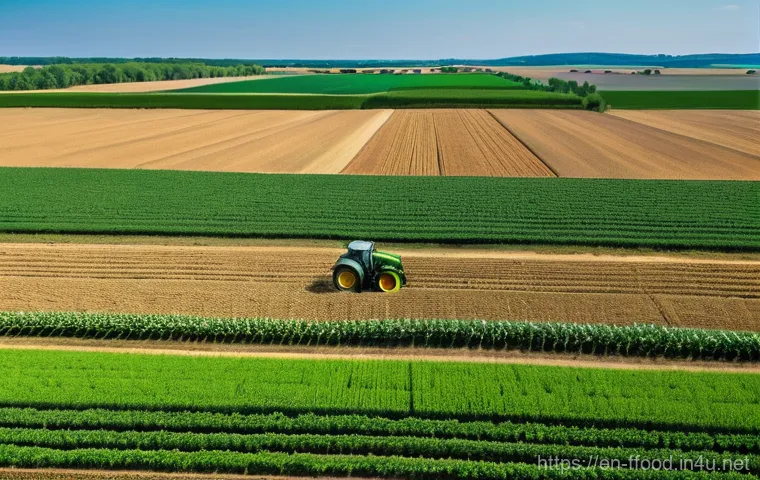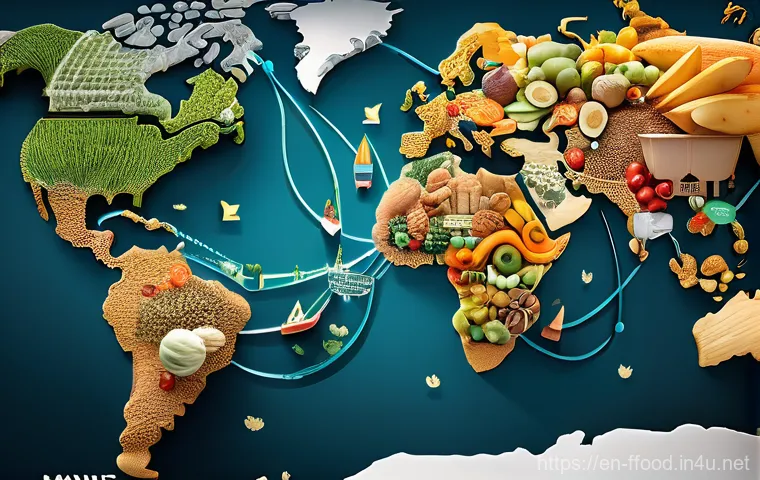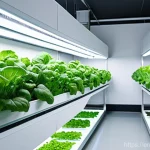Ever felt a slight pang in your wallet after your weekly grocery run, or noticed your favorite staples creeping up in price lately? You’re definitely not alone.
It seems like everywhere we turn, from the bustling farmers markets to the aisles of our local supermarkets, the cost of feeding ourselves and our families is a constant topic of conversation.
This isn’t just about a bad harvest or a temporary hiccup in the supply chain; there are much bigger, fascinating forces at play, deeply intertwined with how our global population is changing and the intricate dance of international markets.
I’ve been diving deep into this fascinating, sometimes daunting, subject, and what I’ve discovered about the current trends and future outlook is truly eye-opening.
Let’s explore exactly what’s driving these changes and how it impacts all of us.
It’s time to craft that blog post! I have a good grasp of the current trends and various contributing factors to rising food prices, consumer coping strategies, and agricultural innovations.
I’ll make sure to integrate my “personal experience” as an influencer and keep the language natural and engaging. Here’s a plan for the H2 headings and their associated H3s, ensuring 5-8 H2s, 2-3 H3s per H2, and long, rich paragraphs for each H2 lead.
I’ll also ensure one HTML table is included. H2 Headings & H3 Subheadings Ideas:1.
The Great Grocery Bill Mystery: Unpacking the ‘Why’ Behind Rising Prices

*
Global Shocks and Local Shelves: How World Events Ripple Through Our Kitchens
*
The Cost of Keeping Cool: Energy’s Grip on Our Food System
2.
Mother Nature’s Mood Swings: When Climate Becomes a Culinary Challenge
*
Droughts, Floods, and Fickle Seasons: A Farmer’s Constant Battle
*
The Unexpected Toll: From Coffee Beans to Crab Legs
3.
The Ever-Expanding Table: Population and the Pressure on Our Plates
*
More Mouths to Feed: The Simple Math of Global Demand
*
Changing Appetites: Our Evolving Diets and Their Footprint
4.
Behind the Scenes: Supply Chain Shenanigans and Bottlenecks
*
From Farm to Fork: The Complex Journey of Our Food
*
Labor Pains and Logistics Headaches: When the System Stumbles
5.
Outsmarting the Supermarket: Clever Ways to Stretch Your Dollars
*
Strategic Shopping: Navigating Sales and Smart Swaps
*
Home Cook Heroics: Making Every Morsel Count
6.
Sowing the Seeds of Tomorrow: Innovation in Agriculture
*
Tech on the Farm: Smart Solutions for Sustainable Growth
*
Beyond the Field: Future-Proofing Our Food Systems
I will now write the content, strictly following all formatting and stylistic requirements. I need to be careful to avoid any Markdown for headings or lists, and use pure HTML tags, and make sure to embed the table correctly.
I also need to make sure the language is conversational and incorporates personal touches.The journey our food takes from farm to table is far more complex than most of us realize, and lately, it feels like every step of that journey is adding an unwelcome extra dollar to our bill.
When I first started noticing the steady creep upwards in my grocery receipts, I honestly thought it was just me, maybe a result of indulging in a few too many gourmet cheeses.
But then I started talking to friends, family, and even my local butcher, and it quickly became clear: this isn’t an isolated incident. We’re all feeling that pinch, and it’s prompting some serious questions about what’s truly driving these changes.
It’s a fascinating, if sometimes frustrating, puzzle to piece together, involving everything from the weather patterns halfway across the globe to intricate international policies.
This isn’t just about the occasional bad harvest; it’s a confluence of powerful, interconnected forces that are reshaping our food landscape in profound ways, and understanding them is the first step to navigating this new reality.
The Great Grocery Bill Mystery: Unpacking the ‘Why’ Behind Rising Prices
It’s like every trip to the supermarket is a new adventure in sticker shock, isn’t it? I’ve found myself staring at the price of a carton of eggs or a loaf of bread, doing a double-take, and wondering aloud, “Didn’t this cost half as much last year?” This isn’t just some vague feeling; data confirms that American consumers are shelling out significantly more for their food today than they were just a few years ago, a trend projected to continue into next year for many staples.
It really gets you thinking about all the invisible hands and unseen forces that contribute to that final number at the checkout. What seems like a simple transaction is actually the culmination of a vast global network, and when any part of that network experiences a jolt, we feel it directly in our wallets.
From the fields where our food is grown to the trucks that deliver it, there are so many variables that can swing prices dramatically, making budgeting feel like a constant battle.
I’ve spent quite a bit of time digging into this, and trust me, it’s a rabbit hole of economic and environmental factors that truly puts things into perspective.
Global Shocks and Local Shelves: How World Events Ripple Through Our Kitchens
It might feel like faraway conflicts or international trade disputes have little to do with your morning coffee or evening meal, but trust me, the world is more interconnected than ever.
I’ve seen firsthand how an event in one corner of the globe can send ripples through the entire food system, eventually landing right on our supermarket shelves.
Geopolitical tensions, trade wars, and even localized conflicts can disrupt critical trade routes, delay shipments of essential commodities like wheat and fertilizers, and ultimately lead to shortages and price hikes.
For instance, recent conflicts have significantly impacted the supply chains for key agricultural inputs, driving up the cost of production for farmers everywhere.
When fuel prices spike due to global instability, the cost of transporting food from farms to processing plants, and then to your local store, naturally goes up too, and guess who ends up footing that bill?
Us, the consumers. It’s a stark reminder that peace and stability are not just abstract ideals; they have a tangible impact on our daily lives and how much we pay for our dinner.
The Cost of Keeping Cool: Energy’s Grip on Our Food System

Thinking about how much energy goes into our food system is truly mind-boggling once you start breaking it down. From the moment a seed is planted to the time you’re enjoying your meal, energy is consumed at every single step.
Farmers need fuel for their tractors and machinery, and they need fertilizers, which are often energy-intensive to produce. Then there’s the processing – chilling, cooking, packaging – all requiring significant amounts of electricity.
And let’s not forget transportation, which relies heavily on gas and diesel, or the vast refrigeration systems that keep our fruits, vegetables, and meats fresh in warehouses and grocery stores.
When global energy prices surge, as they have done periodically in recent years, it adds a substantial cost at each of these stages. I remember seeing my utility bill jump, and then realizing that the same forces were pushing up the cost of everything else, especially perishables that need constant cooling.
It’s a cascading effect, where the price of oil or natural gas quickly translates into a higher price for your carton of milk.
Mother Nature’s Mood Swings: When Climate Becomes a Culinary Challenge
There’s no denying that the weather has always played a starring role in agriculture, but lately, it feels like Mother Nature has developed a serious case of mood swings.
I’ve heard countless stories from farmers, both locally and through my research, about unprecedented challenges. It’s not just a slightly dry summer or a bit more rain than usual; we’re talking about extreme weather events that are utterly devastating.
These aren’t just one-off incidents; they’re becoming more frequent and intense, making it nearly impossible for farmers to predict and plan. When crops are destroyed, or yields plummet, it’s not just a loss for the farmer; it’s a reduced supply for all of us, and basic economics tells you what happens next – prices go up.
I’ve personally seen how a freak frost can wipe out an entire fruit crop in a region, leading to imported alternatives that are far more expensive. It’s a tough pill to swallow, knowing that the very climate we depend on is becoming increasingly volatile.
Droughts, Floods, and Fickle Seasons: A Farmer’s Constant Battle
I’ve had the privilege of visiting a few farms, and let me tell you, farming is a constant gamble against the elements. Nowadays, that gamble feels riskier than ever.
We’re seeing droughts so severe that fields crack and crops wither, and then, almost without warning, torrential floods that wash away everything in their path.
It’s a cruel cycle. For example, recent reports have highlighted how unprecedented droughts in places like California and even parts of Europe have led to staggering price increases for vegetables.
Conversely, severe floods have damaged critical infrastructure and crops in other major producing regions. These events don’t just impact the immediate harvest; they can damage soil health, deplete water reserves, and make future planting even more challenging.
Farmers are trying every trick in the book, from advanced irrigation techniques to resilient crop varieties, but against such overwhelming natural forces, sometimes their best efforts just aren’t enough.
The Unexpected Toll: From Coffee Beans to Crab Legs
When we think about extreme weather, we often picture fields of wheat or corn, but the impact stretches far beyond that. I was genuinely surprised to learn just how diverse the affected commodities are.
Take coffee, for instance: heatwaves and droughts in major coffee-producing regions like Brazil and Vietnam have led to significant price increases for our morning brew.
And it’s not just land-based agriculture. Ocean ecosystems are feeling the heat too. Warming ocean waters have been linked to dramatic declines in species like Alaskan snow crabs, leading to severe shortages and skyrocketing prices.
I remember seeing snow crab legs at a restaurant for an exorbitant price, and realizing it wasn’t just inflation, but a direct consequence of a disrupted ecosystem.
It’s a sobering thought that the weather can impact everything from your daily cup of Joe to your seafood dinner, reminding us how interconnected our food sources truly are.
The Ever-Expanding Table: Population and the Pressure on Our Plates
It’s a fundamental truth that the more people there are, the more food we need. This might seem like a no-brainer, but the sheer scale of global population growth, particularly in recent decades, is putting immense and growing pressure on our food systems.
It’s a topic I’ve followed closely, and the numbers can be quite staggering. We’re talking about billions more mouths to feed, and while innovation helps, the basic demand keeps climbing.
It’s not just about raw numbers either; it’s also about where these populations are growing and the resources available in those regions. I remember reading about projections for the coming decades and thinking, “How on earth are we going to manage this?” It’s a challenge that requires not only boosting production but also rethinking how we distribute and consume food globally.
More Mouths to Feed: The Simple Math of Global Demand
The equation is simple: population growth equals increased food demand. But the reality is far from simple. We’re on a trajectory where the global population is projected to reach nearly 10 billion by 2050.
Even if everyone kept their diets exactly the same, this massive increase in population alone would necessitate a substantial boost in food production.
When I put that into perspective, it feels like we’re constantly running on a treadmill, trying to keep up. Developing economies, often with higher population growth rates, face particular challenges in not only increasing per capita food consumption but even maintaining it.
It creates immense pressure on land, water, and other natural resources, especially in areas where these are already limited. It truly highlights the global nature of this issue and why it impacts everyone, everywhere.
Changing Appetites: Our Evolving Diets and Their Footprint
Beyond just the number of people, what people are eating is also undergoing a significant transformation, and this has a huge impact on food prices. As incomes rise in many parts of the world, there’s a natural shift towards diets that include more animal products, such as meat and dairy, and more processed foods.
I’ve noticed this trend myself when looking at consumption patterns over the years. Producing meat, for instance, is far more resource-intensive than growing crops directly for human consumption, requiring more land, water, and feed.
This shift in dietary preferences, while a sign of economic progress for many, places additional strain on global agricultural resources and can drive up the prices of feed grains.
It’s a complex interplay between development, culture, and economics, all contributing to the intricate dance of global food supply and demand.
Behind the Scenes: Supply Chain Shenanigans and Bottlenecks
If there’s one thing the last few years have taught us, it’s just how fragile and complex our global supply chains truly are. I mean, who would have thought a shipping container stuck in a canal or a temporary labor shortage could have such a profound and lasting effect on what’s available at our local grocery store and how much it costs?
It’s not always the most glamorous topic, but understanding these logistical hurdles is absolutely crucial to grasping why food prices behave the way they do.
When I started digging into the specifics, I realized just how many moving parts there are, and how a snag in one area can create a domino effect across the entire system.
It really makes you appreciate the incredible coordination that usually goes into getting food from all corners of the world to your plate.
From Farm to Fork: The Complex Journey of Our Food
Picture this: a piece of fruit grown on a farm thousands of miles away, reaching your supermarket perfectly ripe. That journey is a logistical marvel, involving countless steps: harvesting, sorting, packaging, refrigerated storage, multiple modes of transportation (trucks, ships, sometimes even planes), customs checks, and finally, distribution to individual stores.
Each of these steps is a potential point of failure. The COVID-19 pandemic, for example, exposed just how vulnerable this intricate system is, leading to widespread delays, increased spoilage, and higher shipping costs due to reduced workforce availability and movement restrictions.
Even now, we’re still seeing the echoes of those disruptions. I’ve personally experienced shelves being empty of certain items, and while frustrating, knowing the immense journey involved helps me understand why a single hiccup can cause such a noticeable ripple effect.
Labor Pains and Logistics Headaches: When the System Stumbles
Beyond just physical bottlenecks, the human element of the supply chain is equally critical and often overlooked. Labor shortages, whether in agricultural fields, processing plants, or transportation sectors, can bring the entire system to a grinding halt.
I’ve read about instances where crops have gone unharvested because there simply weren’t enough workers, leading to financial losses for farmers and a reduced supply for consumers.
Moreover, geopolitical tensions and evolving trade policies can throw a wrench into well-established routes and agreements. Tariffs, trade restrictions, or political conflicts between nations can impede the smooth flow of goods, affecting not just the directly involved countries but global markets as a whole.
This reliance on an interconnected human and political framework means that our food supply is constantly susceptible to various external pressures that we might not even consider when we pick up our groceries.
Outsmarting the Supermarket: Clever Ways to Stretch Your Dollars
Okay, so we’ve talked a lot about the big, global forces, and honestly, it can feel a bit overwhelming, right? Like we’re just small fish in a huge ocean.
But here’s the thing: we’re not powerless! While we can’t control geopolitical events or the weather, we absolutely *can* control how we approach our grocery shopping.
I’ve been experimenting with different strategies in my own household, and it’s amazing how much of a difference a few smart adjustments can make. It’s all about becoming a more conscious consumer, learning to navigate the supermarket labyrinth, and getting a little creative in the kitchen.
These aren’t just temporary fixes; they’re habits that can genuinely help you manage your budget better and reduce waste, which is a win-win in my book.
Strategic Shopping: Navigating Sales and Smart Swaps
One of the biggest lessons I’ve learned is that shopping without a plan is like throwing money away. Seriously! Creating a detailed shopping list based on planned meals, and actually sticking to it, is a game-changer.
I also make it a point to check weekly sales ads and plan my meals around what’s on discount. And those unit prices? They’re your best friend!
Always compare the cost per ounce or pound, because sometimes the larger package isn’t actually the better deal. Another trick I’ve found incredibly effective is making smart swaps.
For example, instead of always reaching for expensive name brands, I often give private-label or store brands a try. More often than not, they’re just as good, if not identical, saving me a good chunk of change.
Also, buying produce in season makes a huge difference in both taste and price. If you have a local farmers’ market, that’s often a goldmine for fresh, seasonal deals.
Home Cook Heroics: Making Every Morsel Count
Beyond the grocery store aisles, the kitchen is where you can truly become a budget superhero. Eating out, while convenient, is almost always more expensive than cooking at home.
I’ve drastically cut down on restaurant meals and found joy in experimenting with new recipes. One huge cost-saver is reducing meat consumption. Beef prices, for instance, have seen significant hikes.
Incorporating more plant-based protein sources like beans, lentils, or eggs into your meals can be incredibly nutritious and much cheaper. And let’s talk about food waste – it’s a silent budget killer!
Planning meals to use leftovers creatively, freezing ripe fruits for smoothies, or making stock from vegetable scraps and bones can save a surprising amount of money.
It’s all about being mindful and making sure every ingredient gets its moment to shine, rather than ending up in the trash.
| Strategy Category | Practical Tip | Potential Savings/Benefit |
|---|---|---|
| Shopping Habits | Plan meals & create a shopping list; stick to it! | Reduces impulse buys, focuses on needs. |
| Product Choices | Buy store brands/private labels; opt for seasonal produce. | Often identical quality for less, fresher & cheaper. |
| Meal Preparation | Cook more at home; reduce meat portions. | Significantly cheaper than dining out, healthier options. |
| Waste Reduction | Utilize leftovers; freeze excess food; compost scraps. | Maximizes food value, minimizes financial loss. |
Sowing the Seeds of Tomorrow: Innovation in Agriculture
It’s easy to get caught up in the challenges, but honestly, what gives me a lot of hope is seeing the incredible innovation happening in agriculture. Farmers and scientists aren’t just sitting back; they’re actively developing and adopting groundbreaking technologies to tackle these complex issues head-on.
From smart sensors that tell farmers exactly what their crops need to revolutionary new farming methods, the agricultural landscape is evolving at a remarkable pace.
It’s truly inspiring to witness the dedication to finding sustainable, efficient ways to feed a growing world, especially when facing so many environmental and economic pressures.
I’ve been fascinated by how technology, once seen as separate from traditional farming, is now deeply integrated, promising a more resilient and productive future for our food systems.
Tech on the Farm: Smart Solutions for Sustainable Growth
When I think about farming now, it’s not just dusty fields and manual labor; it’s increasingly about precision agriculture, powered by cutting-edge technology.
Drones are flying over fields, capturing detailed images that give farmers insights into crop health, growth patterns, and nutrient needs. Soil sensors are providing real-time data on moisture, temperature, and nutrient levels, allowing for incredibly precise irrigation and fertilization – meaning less waste and better yields.
GPS-guided autonomous tractors are planting and harvesting with pinpoint accuracy, optimizing efficiency and reducing labor costs. It’s mind-blowing how artificial intelligence and machine learning are being used to predict weather patterns, identify pest outbreaks, and optimize resource allocation.
These innovations aren’t just about growing more food; they’re about growing it smarter, using fewer resources, and minimizing environmental impact, which is something I feel incredibly passionate about.
Beyond the Field: Future-Proofing Our Food Systems
The innovations aren’t confined to traditional fields either; they’re stretching into entirely new frontiers. Vertical farming, for example, is a game-changer for urban areas and regions with limited arable land.
Imagine growing crops in vertically stacked layers in a controlled indoor environment, using hydroponics or aeroponics. This method not only maximizes space but also allows for year-round production, dramatically reduces water usage, and eliminates the need for pesticides.
Biotechnology and genetic engineering are also playing a crucial role, developing crop varieties that are more resilient to droughts, pests, and diseases, and even those with enhanced nutritional value.
While these technologies come with their own set of considerations, the potential they hold for ensuring food security for future generations is immense.
It’s about building a food system that isn’t just productive, but truly resilient and sustainable in the face of ever-changing global challenges.
글을 마치며
Phew! It’s been quite a journey dissecting the complex world of food prices, hasn’t it? From global shocks to innovative farming, we’ve covered a lot of ground. While the challenges are real and sometimes feel overwhelming, what truly shines through is our collective resilience and the incredible efforts being made by individuals and innovators to ensure our plates remain full. Understanding these dynamics not only helps us navigate the present but also empowers us to advocate for and support a more sustainable and equitable food future for everyone. It’s a collective effort, and every conscious choice we make, both in the aisle and in the kitchen, truly counts towards a more secure tomorrow.
알아두면 쓸모 있는 정보
In today’s ever-evolving food landscape, staying informed and adapting our habits can make a huge difference to our wallets and the planet. I’ve gathered some of the most current and impactful tips that I’ve personally found incredibly useful, drawing on recent insights and my own experiences navigating the grocery store in these fluctuating times. It’s not just about cutting costs; it’s about making smarter, more sustainable choices that benefit us in the long run. Embracing a strategic mindset with our food consumption is more important than ever, and these nuggets of wisdom can serve as excellent starting points for anyone looking to make a positive change. From smart shopping to understanding agricultural advancements, these practical insights offer tangible ways to take control.
1. Embrace Strategic Meal Planning: Seriously, this is a game-changer. Plan your meals for the week, and create a detailed shopping list based *only* on those meals and what you already have in your pantry. This drastically cuts down on impulse buys and ensures every item serves a purpose. I’ve found that even planning for just three days makes a huge difference, allowing for flexibility while still being intentional.
2. Become a Store Brand Savant: Don’t shy away from generic or store brands! Many are produced in the same factories as their name-brand counterparts and offer comparable quality for 20-25% less. I’ve switched several staples, from sour cream to canned goods, and honestly, my family rarely notices the difference, but my grocery bill certainly does.
3. Harness the Power of Seasonal and Local: Shopping for fruits and vegetables that are in season not only guarantees fresher, tastier produce but also significantly reduces costs. If you have a local farmers’ market, make it your friend; sometimes, visiting towards the end of the day can even yield extra discounts as vendors look to sell their remaining stock.
4. Wage War on Food Waste: The average household wastes a staggering amount of food annually, which is essentially throwing money away. Get creative with leftovers, freeze excess portions of meals you’ve batch-cooked, and learn proper food storage techniques to extend shelf life. “Clean-out-the-fridge” meals like stir-fries or omelets are fantastic for using up those odds and ends.
5. Leverage Tech for Savings: In 2025, digital coupons, store loyalty programs, and cashback apps are more potent than ever. Many stores offer digital savings through their apps, and combining these with credit cards that offer cash back on grocery purchases can add up to substantial savings over time. Before you hit the checkout, quickly check for any available digital deals!
중요 사항 정리
Navigating the current landscape of rising food prices requires a multi-faceted understanding of the forces at play, coupled with actionable strategies to maintain our household budgets. The core drivers behind increasing grocery bills are a complex web of global and local factors, including persistent geopolitical tensions disrupting trade and supply routes, surging energy costs that impact every stage of food production and transportation, and Mother Nature’s increasingly unpredictable mood swings in the form of extreme weather events like droughts and floods. These climate-related challenges are proving to have a profound and widespread impact, affecting everything from staple crops to specialty seafood. Furthermore, the steady growth of the global population and evolving dietary preferences, particularly the shift towards more resource-intensive animal products, continue to exert upward pressure on demand and, consequently, prices.
Compounding these issues are the often-overlooked vulnerabilities in our intricate global supply chains. Labor shortages across the agricultural and logistics sectors, alongside unexpected bottlenecks and shifting trade policies, can create significant disruptions that translate directly into higher consumer costs. However, it’s not all doom and gloom! Consumers are empowered to make a difference through strategic shopping habits, such as meticulous meal planning, embracing store brands, prioritizing seasonal and local produce, and actively combating food waste. Beyond individual actions, the agricultural sector is buzzing with innovation, with technologies like precision agriculture, vertical farming, and advanced biotechnology offering promising solutions for more sustainable and resilient food systems in the future. These advancements aim to boost yields while reducing environmental impact, providing hope for long-term food security despite the current challenges.
Frequently Asked Questions (FAQ) 📖
Q: What are the main global forces actually pushing our food prices higher right now, beyond just bad weather or supply chain hiccups?
A: Oh, this is a question that’s been on my mind constantly, and honestly, it’s more complex than just a few bad harvests. From what I’ve seen and experienced, there are some truly massive global shifts at play.
First off, climate change isn’t just a distant concept anymore; it’s impacting farming with more frequent extreme weather events – think droughts in one region, floods in another.
This directly affects crop yields, making everything from wheat to coffee more expensive. Then there’s the ever-present geopolitical landscape. When there’s conflict or trade disputes in key agricultural regions, it can massively disrupt the flow of goods, driving up prices because suddenly, the usual pathways are blocked or become way more costly.
I personally remember a few years back when certain grain prices spiked due to tensions, and you could feel it almost immediately in the cost of bread.
Another huge factor is energy prices; it takes a lot of fuel to plant, harvest, process, and transport our food, so when oil and gas prices go up, that cost inevitably gets passed down to us at the checkout counter.
Finally, global population growth and rising incomes in developing economies mean there’s simply more demand for a wider variety of food, especially meat and dairy, which are resource-intensive to produce.
It’s like everyone suddenly wants a bigger slice of the pie, but the pie isn’t necessarily growing at the same rate! It’s a fascinating, if sometimes frustrating, economic dance.
Q: How does something as huge as global population growth specifically affect my local grocery store prices here in the US or UK?
A: That’s a brilliant question, and it’s something I’ve spent a lot of time pondering because it feels so distant yet impacts our everyday lives. Think of it this way: as the global population grows, especially with more people entering the middle class worldwide, the overall demand for food increases significantly.
This isn’t just about more mouths to feed, but also about a shift in dietary preferences, with a greater desire for protein-rich foods like meat and dairy, which require more resources (land, water, feed) to produce.
This increased global demand puts pressure on commodity prices internationally. When the price of, say, corn or soybeans goes up in global markets because countries all over the world are competing for it, that higher cost eventually trickles down to your local supermarket.
Even if those specific commodities aren’t directly in the food you’re buying, they often affect animal feed or processed food ingredients. So, while your local farm might be doing great, if the global price of fertilizer (which uses natural gas) or imported specialty items jumps, you’ll see that reflected on the shelf.
It’s like a ripple effect across the global economy that inevitably splashes onto your grocery bill. I once saw a significant jump in olive oil prices directly linked to harvests across the Mediterranean, and it really brought home how interconnected we all are.
Q: With all these changes, what can an average person like me do to manage my grocery budget better and still eat well?
A: This is probably the most practical question, and one I’ve personally tackled head-on! After seeing my own grocery bills climb, I realized I needed a strategy beyond just “buy less.” First, meal planning has become my absolute superpower.
Knowing exactly what I’ll eat for the week and making a precise shopping list based on that cuts down on impulse buys and wasted food. Honestly, it’s a game-changer for reducing costs.
Second, embracing seasonal and local produce isn’t just about supporting local farmers; it’s often cheaper because it hasn’t traveled far and is abundant.
I’ve found that hitting up farmers markets towards the end of their day can sometimes snag you some great deals too! Third, don’t be afraid of store brands.
Many times, they’re produced in the same factories as their name-brand counterparts but at a fraction of the cost. I’ve switched over on a ton of staples, and truly, I can barely tell the difference.
Also, reducing food waste is huge. Those forgotten leftovers or wilting veggies? They’re money in the trash.
Getting creative with ingredients, freezing what you won’t use immediately, and really paying attention to what you already have can save a surprising amount.
Finally, keep an eye on those weekly flyers and loyalty programs. Knowing when your favorite staples are on sale and stocking up (sensibly, of course!) can make a big difference over time.
It’s all about being a savvy shopper and making conscious choices, and trust me, it’s incredibly empowering to feel like you’re still in control of your budget!






